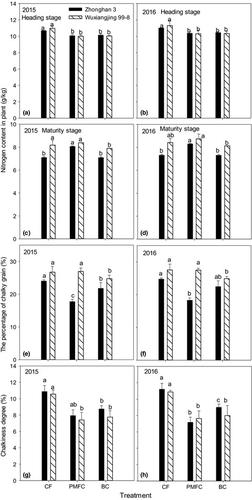当前位置:
X-MOL 学术
›
Food Energy Secur.
›
论文详情
Our official English website, www.x-mol.net, welcomes your feedback! (Note: you will need to create a separate account there.)
The effects of dry cultivation on grain‐filling and chalky grains of upland rice and paddy rice
Food and Energy Security ( IF 5 ) Pub Date : 2020-02-03 , DOI: 10.1002/fes3.198 Yajie Zhang 1 , Gaosheng Liu 1 , Yadan Cheng 1 , Jingnan Xu 1 , Chen Wang 1 , Jianchang Yang 1
Food and Energy Security ( IF 5 ) Pub Date : 2020-02-03 , DOI: 10.1002/fes3.198 Yajie Zhang 1 , Gaosheng Liu 1 , Yadan Cheng 1 , Jingnan Xu 1 , Chen Wang 1 , Jianchang Yang 1
Affiliation

|
An important challenge facing rice production in China is to solve the problem of declining freshwater supply without affecting grain yield and quality. The purpose of this study was to investigate the effects of cultivation methods on the grain‐filling and chalk grains of Zhonghan 3 (Japonica) upland rice and Wuxiangjing 99–8 (Japonica) paddy rice. Both cultivars were cultivated in fields under three cultivation methods: continuous flooding (CF) as a control, bare dry cultivation (BC), and plastic film mulching dry cultivation (PFMC). Compared with CF, the yield of the upland rice decreased significantly, and the yield of paddy rice did not differ significantly under PFMC. The yields of both cultivars decreased significantly under BC. Superior and inferior grains of the two cultivars under PFMC had a greater mean grain‐filling rate (G) and a shorter active grain‐filling time (D). Under PFMC, the two cultivars had a higher export translocation rate of the matter from the stem and sheath and a slower decrease of the chlorophyll content in the flag leaves and nitrogen content in the plants after heading. Upland rice had a higher grain weight, and paddy rice had a lower grain weight compared to CF. The chalkiness of the two cultivars was significantly lower under dry cultivation than under CF. The correlation analysis showed that the percentage of chalky grains was negatively correlated with G and positively correlated with D, indicating that dry cultivation could improve the grain‐filling rate and appearance quality of the two cultivars.
更新日期:2020-02-03



























 京公网安备 11010802027423号
京公网安备 11010802027423号